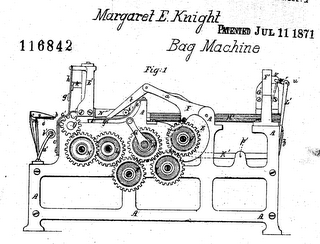Lady Edisons

This weekend's TV theme at our house is Inventors and Inventions, and I've loads to tell about female inventors and their roles in our daily lives.
The US Patent Act of 1790 changed the rules and allowed women to hold patents if they were single or widowed. Since married women of the time were not allowed to own property in most states, and patents are intellectual property, most women could not hold patents despite the Patent Act. The first woman to hold a patent was Mary Dixon Kies, who lived in Connecticut, where law did not prevent married women from owning property independently. Her patent, issued 15 May 1809, was for a method of weaving straw and silk together to make hats. At the time, the United States had an embargo in effect on European goods (blame Napoleon) and the economy in the New England states, which had been heavily supported by imports, was suffering. Kies' method made it possible to produce hats quickly and efficiently, bolstering the local economy. (I looked for Kies' original patent document - it was apparently destroyed by a fire at the Patent Office in 1836.)
Margaret Knight absorbed her education of mechanics while working in paper and textile mills as a preteen and teenager. In 1868 she was working at a paper bag company in Massachusetts when she developed a machine that would automate the production of square-bottomed paper bags. (At the time, most paper bags had envelope-style bottoms; square-bottomed bags were handmade and prohibitively expensive for mass production.) She built a wood model of her machine and brought it to a machinist, since the patent office required an iron model. While the machinist was working on the job, a man saw Knight's machine and stole her patent. She brought a patent interference lawsuit against him, and won her patent in 1871. Her opponent's main defense in court was that a woman could not have possibly created such a mechanical invention. During this time, newspapers patronizingly referred to Knight as "Lady Edison". Over the course of her lifetime, Margaret Knight held many patents for machines relating mostly to textile and fashion industries.
Mary Engle Pennington was a chemist who specialized in bateriology. She researched safe handling of milk and dairy products, eventually convincing dairy farmers and street ice cream vendors to change some of their procedures to make their products safer. In 1905 she applied for a job with the USDA under the name "M. E. Pennington". Apparently the government did not realize she was female until after she received a promotion in 1906. Mary Engle Pennington designed refrigerated railroad cars, which allowed perishables to be shipped safely all over the country, and also improved the shipping of eggs with a new design for egg cartons.
One unlikely inventor is Hedy Markey, better known as Hedy Lamarr, who, together with pianist and composer George Antheil, developed a method of encoding radio signals called frequency hopping, an example of spread spectrum. Their method, which they patented in 1942, was based on the idea that radio transmissions could be hidden if they switched frequencies in a pattern that would be difficult for an eavesdropper to trace but easy to follow for someone with the appropriate key (in this case, a piano roll from a player piano). The government turned down the opportunity to buy a license for their method during WWII, but spread spectrum is used today in radio and cell phone technologies to make transmissions less prone to interference and eavesdropping.
And kevlar! Stephanie Kwolek first created kevlar fibers while working as a research chemist at DuPont in 1971. And Liquid Paper, which was invented by Betty Nesmith, a typist who enjoyed painting as a hobby, and mixed her own version of a white paint that would enable her to better correct mistakes. It goes on and on - windshield wipers, signal flares, no-wrinkle cotton - tons of stories about women inventing stuff. More good info here. I'm off to go tinker in the basement.
No comments:
Post a Comment